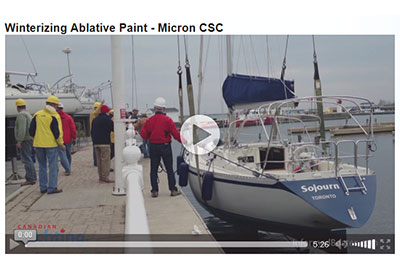Ask the Experts with Rob Macleod – Ablative Bottom Paint

 This fall, while hauling boats Tim and I got into a discussion about the best way to prepare boats with ablative paints for winter storage. The question came up when I passed on having our boat’s hull power washed as Sojourn sat on the cradle. All the boats around Sojourn had harder bottom paints, which are intended for racing boats. The power washing, as you can see, took off all of the growth but left the bottom paint intact.
This fall, while hauling boats Tim and I got into a discussion about the best way to prepare boats with ablative paints for winter storage. The question came up when I passed on having our boat’s hull power washed as Sojourn sat on the cradle. All the boats around Sojourn had harder bottom paints, which are intended for racing boats. The power washing, as you can see, took off all of the growth but left the bottom paint intact.
Both Tim and I use an ablative paint – specifically Interlux Micron CSC. In a discussion with one chandlery, I was cautioned against power washing the bottom, because it tended to remove the paint, as well as the growth. Tim was advised by another chandlery that he should power wash his hull to clean off any growth and make sure the bottom was ready for painting in the spring.
I emailed Interlux Paint’s support department and got a call back from Jeremy Dolan in Application Support. With Jeremy’s background in product development, he was able to shed a lot of light on the subject of caring for Micron CSC. The first caution Jeremy shared was that not all ablative paint is the same. So the recommendations that follow are for Interlux Micron CSC.
{videobox}qLA45Jd6iZM{/videobox}
The first piece of information is that CSC is a multi-year bottom paint. That means that the boat can be hauled and stored for the winter, then when the boat goes back in the water, the biocide in the paint is just as effective. The second piece of information is that the biocide resides in the resin, not in the blue pigment that you see on the bottom of the boat. Based on these two pieces of information Jeremy recommends the fall preparation of the hull lies between the two recommendations from our chandleries.
Tim and I both applied our CSC bottom paint the same way. We removed all existing bottom paint, then applied one layer of white-coloured CSC. Then we both applied two layers of blue-coloured paint. Micron CSC, being ablative, contains a biocide that kills any growth and as the boat moves through the water, the paint and growth fall off.
You can see on the hull of Sojourn, that after four weeks out of the water, the growth is indeed flaking off and it is taking just a little of the pigment with it. When I looked at Tim’s boat, I saw the white-coloured bottom base coat. Both blue layers were taken off by the high-pressure washer.
Our expert, Jeremy, suggests the answer lies between the no-wash and the high-pressure wash. If the bottom is fairly clean at lift out, a wash with a pressure washer of no more than 1800 psi will take the growth and a little of the pigment off the bottom of the boat. A commercial power washer like the type used on Tim’s boat was rated over 3000 psi and effectively sand blasted the bottom paint off of Tim’s hull.
Because I was out of town for most of the time, our boat actually sat for four weeks before hauling; that lead to a greater build up of growth on Sojourn’s hull. What does not come off with a stiff brush will now have to be sanded down to be able to apply coat of paint on in the spring.
There was a third point that Jeremy made, and that was an environmental concern. If ablative paints, like Micron CSC, are power washed off while the boat is in the slings or on a pier, like our haul out, there will be a higher concentration of biocide going into the surrounding water. By using a lower pressure water, or waiting until the boat is in the compound to wash the hull with a low pressure washer, far less biocide gets back into the water. Any Canadian boater who has cruised to the US, especially the southern states, has seen a significant requirement for marinas to contain any contaminant, like bottom paint. Bottom washing is done in a closed area where all of the water and paint washed off the boat is captured and treated, so no biocides or solid matter get into the surrounding water. If a boat is going to be sanded and or painted, ground collection sheets are spread under the boat so that, again, all waste and contaminants are captured and can be disposed of properly.
So the answer to Tim’s and my question, “To wash or to brush?”
1. After the boat’s bottom is properly prepared according to manufacturer’s instructions and you have applied at least three coats of Micron CSC
2. Take your boat for a good run, just before haul out, to wash off any accumulated growth
3. When the boat is hauled, power wash the hull with just enough pressure (less than 1800 psi) to take any growth off the hull, but not to remove any more pigment (the colour) or resin (contains the biocide) than necessary to make sure the hull can take a fresh coat of bottom paint in the spring
4. Do your best to contain any of the materials washed off your boat to protect the environment
Until next time, I’m Rob MacLeod. Stay Informed.
Related Articles:
* Ask the Experts: Keeping Diesel Fuel Clean Part I – Biocide
* Ask the Experts: Keeping Diesel Fuel Clean Part II – Filters
* Ask the Experts: Keeping Diesel Fuel Clean Part III – Water Separation Filters
* Ask the Experts: Solar Panels – Part I – Power Considerations
* Ask the Experts: Solar Panels – Part II – Solar Technology
* Ask the Experts: Solar Panels – Part III – Installation
* Ask the Experts: Battery Performance and Longevity
* Ask the Experts: Sacrificial Anodes





























